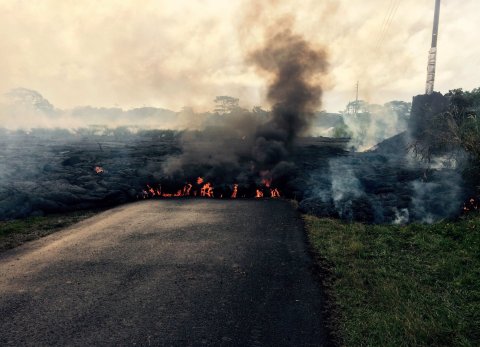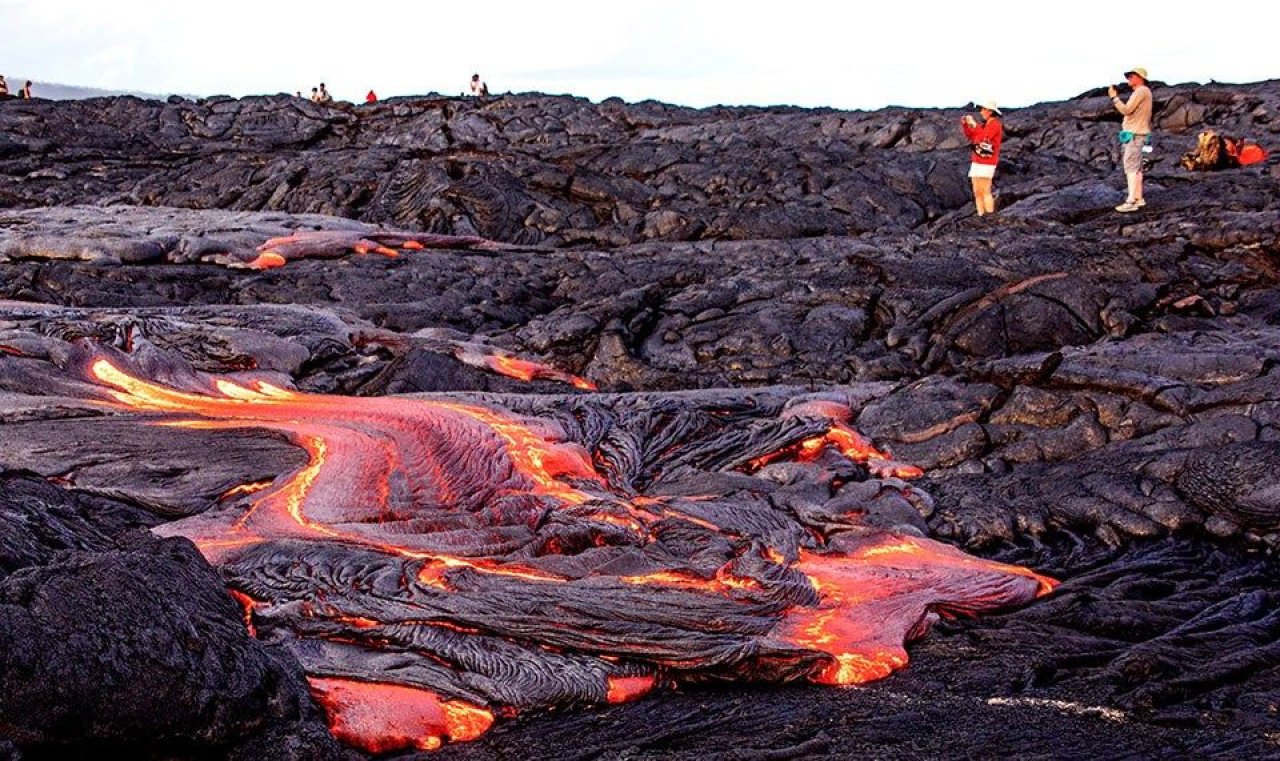With very little fanfare, an American volcano has been erupting for almost 35 years. For a record-breaking phenomenon, researchers are taking the activity at Hawaii's Kilauea remarkably in stride—for now.
"This is pretty normal for the past couple decades," Carolyn Parcheta, a geologist at the U.S. Geological Survey's Hawaiin Volcano Observatory, told Newsweek. "We don't expect the eruption overall to end any time soon." Right now, the decades-long eruption, through a vent known as Pu'u 'Ō'ō, is the longest known modern event, she added, but there's geological evidence of a previous flow that lasted about 60 years. It's just Kilauea's style, she says, "very gentle lava flows."
Right now, Kilauea is erupting in two places: at the main summit since 2008 and at Pu'u 'Ō'ō since May 2016. The latter lava flow is known as 61g because it's the seventh vent flow within the 61st subset of eruptions grouped by volcanic traits. Fortunately, 61g is crossing national park lands straight to the ocean right now. "It's not really bothering anyone," said Christina Neal, the scientist in charge of the observatory. And besides, island residents are used to the volcano doing this and love hiking out to see the lava.
But the volcano has the potential to turn deadly. Even these gentle flows can become risky if they head toward people's homes, as they did in 2014. And even worse, geologic evidence has shown Kilauea actually has two states of being: It can be effusive, as it is now, or explosive. The volcano was most recently explosive between about 1500 and 1800, when it featured lava fountains as high as 2,000 feet and coated its surroundings in 35 feet of volcanic rock fragments called tephra.
That means it's prudent to study the volcano and each lava flow it produces, no matter how tame it may seem. "I think every time Kilauea produces a lava flow like this is a better chance for us to understand how these lava flows behave," Neal said.
One of the big questions the team wants to answer about 61g and its ilk is how much molten rock they're actually leaking. It turns out much of that happens not out in the open but within lava tubes, which hide the flow from scientists' prying eyes. And much of the lava ends up in the ocean, where scientists can't monitor it. It's like a hose, Parcheta says, but there's no faucet with a built-in range of rates. "If we don't have a way to catch the water at the end," she adds, "there's no really good method right now to quantify what that flux is."
To try to solve that puzzle, scientists have turned to thermal cameras, says Matthew Patrick, another geologist on the Kilauea team. Those cameras can see through the clouds of gunk coming out of a volcano and measure how warm or cool certain patches of lava are. Scientists are also finding ways to process that thermal imagery to measure how thick the lava is, which they can then use to measure volume changes and eruption rates at the site.
Right now, the team has rough estimates of how much lava Kilauea is producing: perhaps three or four meters cubed per second at the Puʻu ʻŌʻō vent, or up to about 1,000 gallons per second. (Neighboring Mauna Loa, by comparison, can churn out hundreds of cubic meters of lava per second.) But they know those estimates are on the low side.
Read more: Yellowstone Supervolcano: An Eruption Isn't Coming, But Here's What Scientists Would See
Without better lava flow numbers or a way to watch what's happening underwater, the team can't figure out how much the island is growing. "This is a representation of what Kilauea's done for thousands of years," Neal said. After all, lava is what built the island and all its neighbors.
Right now, there's no reason to be worried about the lava flows, but small changes in activity can mean big changes in risk, which is why the monitoring station is there in the first place. "The particular location of the vent has big implications," Patrick said. And because the cone is fairly brittle, new vents can form, one of the key developments the monitors look for. That surveillance has paid off on days like June 27, 2014, when a new spurt of lava broke out of Pu'u 'Ō'ō and started inching toward the town of Pāhoa. The flow didn't end up doing any damage, but it threatened the community for months on end.

"Currently the changes from day to day typically are relatively small," Neal said of both the summit and the 61g flow. "It's been a pretty steady system for a while now." But she and her team have their eyes peeled for signs the volcano is changing and potentially pushing its way toward an explosive phase.
Keeping on the lookout is tricky, though, because they don't yet know for sure what the signals of that change will be. In particular, the team is monitoring the make-up of lava flows in case they see the magma composition changing. More obvious signs might include the main lava lake draining away or a spike in earthquakes. "That would be a pretty big red flag that we might be moving into some sort of explosive behavior," Neal said.
For now, Kilauea is just doing its thing, as weird as that may seem to those of us who aren't geologists. "61g is further testament to the steady, long-term, persistent nature of this Pu'u 'Ō'ō eruption," Patrick said, "and Kilauea's persistent nature in general."
SaveSave

















